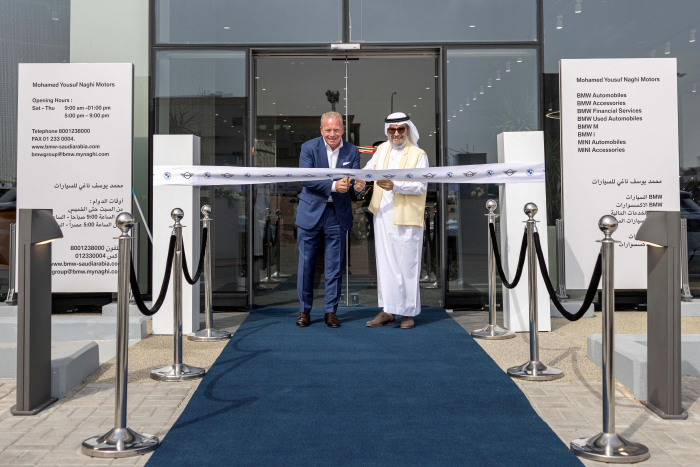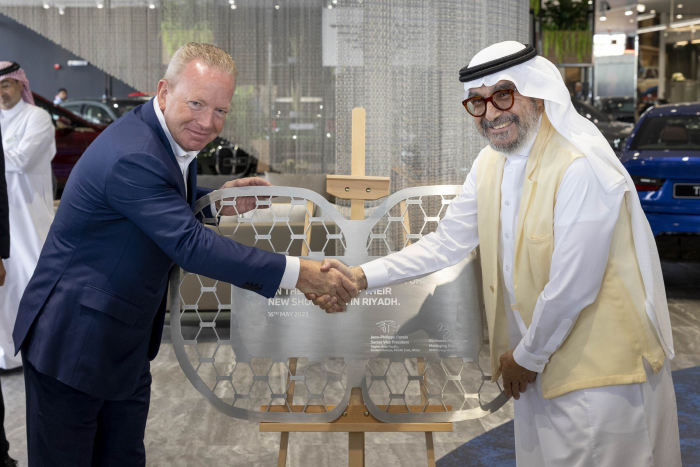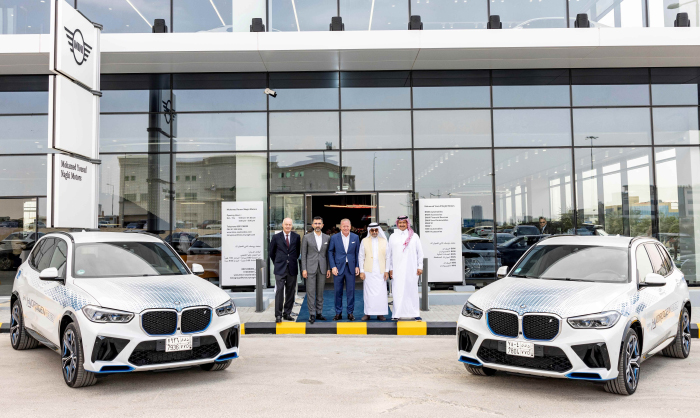Mohamed Yousuf Naghi Motors (MYNM), the official importer of BMW Group vehicles in the Kingdom of Saudi Arabia, announced the opening of its new BMW Group showroom in Riyadh. Based on BMW Group’s ‘Retail.Next’ framework, the principles underpinning the design philosophy include more flexible and stylish interiors, with multi-functional areas and open spaces, and a seamless integration of all customer touchpoints.

The showroom unveiling also saw the debut of the BMW iX5 Hydrogen pilot fleet in the Middle East, which is set to demonstrate the reliability and suitability of alternative emissions-free drive systems for everyday use across the region. Media and industry stakeholders were one of the very first to gain a direct impression of the BMW iX5 Hydrogen through an interactive workshop and driving experiences.

Sheikh Mohammed Naghi, Chairman of Mohamed Yousuf Naghi Motors, said: “I am delighted to open the doors to our new facility, which truly reimagines the traditional showroom experience. Our customers can expect a completely different retail journey – one based on creating a memorable and authentic brand experience. The opening of this showroom is a big milestone in our partnership with BMW Group as we continue working hand-in-hand to deliver excellence for our customers.”
Jean-Philippe Parain, Senior Vice President, Region Asia-Pacific, Eastern Europe, Middle East, Africa at BMW Group, said: “I would like to congratulate MYNM on inaugurating the first Retail.Next showroom in the Kingdom. The new facility will offer our Riyadh-based customers the infrastructure required for all their current and future premium motoring needs, allowing for a seamless journey based on both physical and digital points of interaction”.
Transforming traditional automotive showrooms into carefully designed conversational spaces, the Retail.Next concept puts the spotlight on the most advanced BMW Group models with unique lighting and lounge-like seating.
The strategy overhauls the buying process with salespeople interacting with customers at the vehicle displays – abandoning traditional sales cubicles to embrace the spirit of discovery and adventure that lies at the heart of every vehicle.
The service centre comprises of 18 work bays, including one exclusively for fast-tracked queues, providing the capacity to service up to 60 vehicles per day.
Commenting on the Middle East debut of the BMW iX5 Hydrogen pilot fleet, Parain added: “Today also marks a major milestone in our pursuit to transition towards sustainable mobility in the region. Through a series of initiatives across Middle East markets, the pilot fleet will prove the importance of considering hydrogen as an alternative emissions-free drivetrain. Knowing that not all markets will have the ability to fully adopt battery electric vehicles, hydrogen will play a critical role in complimenting electromobility. This will offer such markets a smoother transition to zero-emissions mobility.”
With hydrogen being one of the most efficient options for storing and transporting renewable energy, it is expected to contribute in achieving net zero carbon emissions by 2050 and to play a major role as a fuel in this region of the world.
The BMW iX5 Hydrogen
Based on the current BMW X5, the BMW iX5 Hydrogen was first unveiled as a concept at the IAA show in 2019. Its centrepiece is the highly efficient next-generation fuel-cell system, generating a high continuous output of 170 hp. In combination with a highly integrated drive unit using fifth-generation BMW eDrive technology, the powertrain channels maximum output of 401 hp onto the road.
Hydrogen Allows Rapid Refuelling
The hydrogen needed to supply the fuel-cell is stored in two 700-bar tanks made of carbon-fibre reinforced plastic (CFRP). Together these hold almost six kilograms of hydrogen, enough to give the BMW iX5 Hydrogen a range of 504 km in the WLTP cycle. Filling up the hydrogen tanks only takes three to four minutes – so the BMW iX5 Hydrogen can also provide the driving pleasure for which BMW is renowned over long distances, with just a few brief stops along the way. This proves to be a necessary advantage in areas which will face limitations with EV charging infrastructure.


COMMENTS